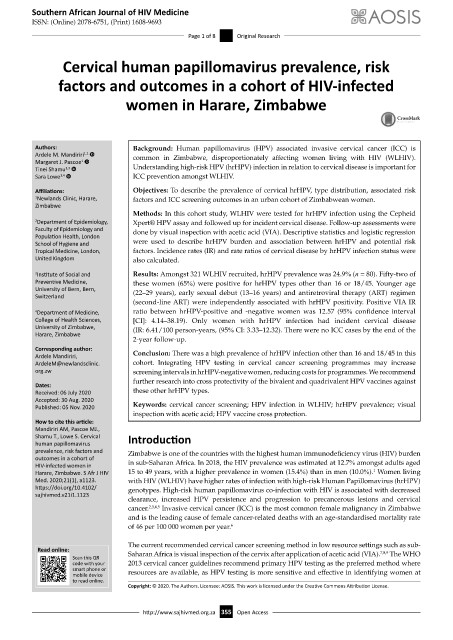Page 363 - HIVMED_v21_i1.indb
P. 363
Southern African Journal of HIV Medicine
ISSN: (Online) 2078-6751, (Print) 1608-9693
Page 1 of 8 Original Research
Cervical human papillomavirus prevalence, risk
factors and outcomes in a cohort of HIV-infected
women in Harare, Zimbabwe
Authors: Background: Human papillomavirus (HPV) associated invasive cervical cancer (ICC) is
Ardele M. Mandiriri common in Zimbabwe, disproportionately affecting women living with HIV (WLHIV).
1,2
1
Margaret J. Pascoe
Tinei Shamu Understanding high-risk HPV (hrHPV) infection in relation to cervical disease is important for
1,3
Sara Lowe ICC prevention amongst WLHIV.
1,4
Affiliations: Objectives: To describe the prevalence of cervical hrHPV, type distribution, associated risk
1 Newlands Clinic, Harare, factors and ICC screening outcomes in an urban cohort of Zimbabwean women.
Zimbabwe
Methods: In this cohort study, WLHIV were tested for hrHPV infection using the Cepheid
2 Department of Epidemiology, Xpert® HPV assay and followed up for incident cervical disease. Follow-up assessments were
Faculty of Epidemiology and done by visual inspection with acetic acid (VIA). Descriptive statistics and logistic regression
Population Health, London
School of Hygiene and were used to describe hrHPV burden and association between hrHPV and potential risk
Tropical Medicine, London, factors. Incidence rates (IR) and rate ratios of cervical disease by hrHPV infection status were
United Kingdom also calculated.
3 Institute of Social and Results: Amongst 321 WLHIV recruited, hrHPV prevalence was 24.9% (n = 80). Fifty-two of
Preventive Medicine, these women (65%) were positive for hrHPV types other than 16 or 18/45. Younger age
University of Bern, Bern, (22–29 years), early sexual debut (13–16 years) and antiretroviral therapy (ART) regimen
Switzerland
(second-line ART) were independently associated with hrHPV positivity. Positive VIA IR
4 Department of Medicine, ratio between hrHPV-positive and -negative women was 12.57 (95% confidence interval
College of Health Sciences, [CI]: 4.14–38.19). Only women with hrHPV infection had incident cervical disease
University of Zimbabwe, (IR: 6.41/100 person-years, (95% CI: 3.33–12.32). There were no ICC cases by the end of the
Harare, Zimbabwe
2-year follow-up.
Corresponding author: Conclusion: There was a high prevalence of hrHPV infection other than 16 and 18/45 in this
Ardele Mandiriri,
ArdeleM@newlandsclinic. cohort. Integrating HPV testing in cervical cancer screening programmes may increase
org.zw screening intervals in hrHPV-negative women, reducing costs for programmes. We recommend
further research into cross protectivity of the bivalent and quadrivalent HPV vaccines against
Dates:
Received: 06 July 2020 these other hrHPV types.
Accepted: 30 Aug. 2020
Published: 05 Nov. 2020 Keywords: cervical cancer screening; HPV infection in WLHIV; hrHPV prevalence; visual
inspection with acetic acid; HPV vaccine cross protection.
How to cite this article:
Mandiriri AM, Pascoe MJ.,
Shamu T., Lowe S. Cervical Introduction
human papillomavirus
prevalence, risk factors and Zimbabwe is one of the countries with the highest human immunodeficiency virus (HIV) burden
outcomes in a cohort of
HIV-infected women in in sub-Saharan Africa. In 2018, the HIV prevalence was estimated at 12.7% amongst adults aged
1
Harare, Zimbabwe. S Afr J HIV 15 to 49 years, with a higher prevalence in women (15.4%) than in men (10.0%). Women living
Med. 2020;21(1), a1123. with HIV (WLHIV) have higher rates of infection with high-risk Human Papillomavirus (hrHPV)
https://doi.org/10.4102/ genotypes. High-risk human papillomavirus co-infection with HIV is associated with decreased
sajhivmed.v21i1.1123
clearance, increased HPV persistence and progression to precancerous lesions and cervical
cancer. 2,3,4,5 Invasive cervical cancer (ICC) is the most common female malignancy in Zimbabwe
and is the leading cause of female cancer-related deaths with an age-standardised mortality rate
of 46 per 100 000 women per year. 6
The current recommended cervical cancer screening method in low resource settings such as sub-
Read online: 7,8,9
Read online:
Scan this QR
Scan this QR Saharan Africa is visual inspection of the cervix after application of acetic acid (VIA). The WHO
code with your
code with your 2013 cervical cancer guidelines recommend primary HPV testing as the preferred method where
smart phone or resources are available, as HPV testing is more sensitive and effective in identifying women at
smart phone or
mobile device
mobile device
to read online.
to read online.
Copyright: © 2020. The Authors. Licensee: AOSIS. This work is licensed under the Creative Commons Attribution License.
http://www.sajhivmed.org.za 355 Open Access

